Abstract
Examining the life cycle of structures, such as concrete dams, holds paramount importance for engineers, as it facilitates a comprehensive assessment of overall sustainability, enabling the balancing of the benefits and costs associated with dam development. The recycling of materials emerges as a crucial factor in mitigating environmental impacts. This study employs the IMPACT 2002+ methodology to perform a life cycle assessment (LCA) of a concrete dam, covering the stages from construction to decommissioning. Additionally, carbon footprint analysis (CFA) and life cycle costing (LCC) are performed to pinpoint greenhouse gas (GHG) emission sources and access economic performance. This investigation spans three key-stages: (1) initial construction; (2) decommissioning; (3) hypothetical scenarios with recycling rates for demolished concrete and steel, evaluating how different recycling percentages influence both the environmental benefits and LCC outcomes. The results emphasize the significance of reducing air pollution, with climate change identified as the primary environmental concern compared to ecosystem and resource indicators. The findings show that the carbon footprint associated with the construction of 1 m width of the dam is estimated to be around 355 ton CO2 eq. Furthermore, the total carbon emissions resulting from the demolition of the dam were identified to amount to 735 ton CO2 eq/m. The recycling of the dam materials after demolition led to a notable reduction in pollution associated with the decommissioning process of the dam, compared to the dams’ destruction without recycling.
1. Introduction
Dams hold a significant role in the water resources management within nations, serving as pivotal structures that contribute not only to flood crisis management, but also fulfill various functions such as water supply, irrigation, and power generation [1,2,3]. Beyond the socioeconomic ramifications, dam deterioration carries the potential for profound environmental repercussions, encompassing both the immediate consequences of failure and the long-term impacts arising from the dam’s presence and operations [4,5]. These include alterations to downstream river ecosystems, habitat loss for aquatic species, and the disruption of animal migration patterns [6,7].
The construction industry, encompassing various activities from raw material extraction to demolition waste recycling, constitutes a significant portion of Europe’s environmental footprint [8,9,10,11]. It represents half of the consumption of natural raw materials, accounts for 40% of total energy use (as the primary consumer), generates 46% of waste, and contributes to 36% of all greenhouse gas emissions. Within this sector, mineral materials, concrete, and other cement-based materials play a significant role in environmental impacts. The vast global production of concrete, reaching 25 billion tons annually, leads to the substantial utilization of natural resources and energy, primarily for cement and reinforcement steel production, as well as for transportation, construction, and demolition. This production also emits large amounts of greenhouse gases, primarily carbon dioxide (CO2) [12], primarily originating from cement production, along with emissions of SO2 contributing to acidification, mainly from transportation. Additionally, it generates a considerable amount of construction and demolition waste, mostly being inert and non-dangerous [13].
The recycling process of materials from the structures’ decommissioning phase has been evaluated, with a focus on concrete and steel. The concrete is crushed and processed to create recycled concrete aggregate (RCA), which can be reused in new concrete mixes for construction projects, reducing the demand for virgin aggregates. The steel is separated and melted down for reuse in various steel products, supporting circular economy principles by minimizing waste and conserving natural resources. These recycled materials not only help in reducing landfill waste, but also lower the environmental impact associated with the extraction and processing of raw materials. RCA, in particular, can be used in a variety of applications, including road base, foundations, and non-structural concrete, although further research is needed to fully evaluate its performance in high-stress structural applications such as dam construction. This recycling process contributes to the sustainability of large-scale projects by enabling the recovery and repurposing of valuable materials, thus reducing both the carbon footprint and life cycle costs of future construction [14]. Research on RCA has demonstrated that while RCA reduces landfill use and conserves virgin materials, it often results in reduced material strength. As a result, additional cement or raw materials may be required to meet performance standards, which introduces economic allocation complexities [15].
However, replacing primary aggregates with RCA does not inherently ensure improved environmental performance across the entire life cycle of a concrete structure. A comprehensive evaluation of sustainability should encompass social and economic dimensions alongside environmental considerations. Therefore, it is imperative to employ scientifically grounded approaches to assess all three aspects of sustainability. For environmental evaluation, the widely accepted and standardized method of life cycle Assessment (LCA) is commonly utilized, enabling the examination of environmental impacts across processes and product life cycles.
Dams play a significant role in GHG emissions due to the extensive use of concrete in their construction, which involves the production of cement, a process known to emit substantial amounts of CO2 during manufacturing [16]. The environmental implications spanning a dam’s complete life cycle could be categorized into construction, maintenance, operation, and decommissioning stages. In pursuit of optimal sustainability in dam construction, LCA offers a valuable framework for exploring the trade-offs inherent in different alternatives [17].
LCA stands as a standardized technique to assess the ecological ramifications of a system or product over its complete life cycle [18]. This comprehensive analysis encompasses factors such as emissions, energy usage, and waste production. LCA has the capacity to gauge both the overall influence of a construction project throughout its existence and the specific effects associated with individual materials employed in its construction. Within the spectrum of environmental aspects subject to LCA scrutiny, the practice of carbon footprint analysis (CFA) emerges, a methodology designed to quantify the cumulative direct and indirect emissions of greenhouse gases (GHGs) stemming from an individual, entity, or product within a defined timeframe. While CO2 represents the most prevalent GHG under consideration, the analysis also encompasses gases like methane (CH4) and nitrous oxide (N2O). Conversely, life cycle costing (LCC) serves as a method employed to appraise the comprehensive economic expenditure linked to a service or product over its life cycle [19].
In the realm of construction, LCA and CFA have been employed to assess the ecological effects stemming from different materials, construction techniques, and the sustainability of projects, as well as pinpoint avenues for enhancing environmental performance [20]. Implementing these approaches on a significant and influential construction holds paramount importance, as it facilitates a balanced assessment of the trade-offs between the advantages and drawbacks linked to its environmental impacts and resource utilization [21]. Researchers have delved into different dimensions of dam analysis within LCA, encompassing aspects like the utilization of dredged sediments [22], the decommissioning of dams [23], the decay of biomass within reservoirs, and the functioning of hydroelectric plants [23,24,25].
Zhang et al. [26] proposed an LCA method for carbon assessment in pumped storage hydropower projects, addressing a gap in estimating emissions at the design stage. By calculating diesel, electricity, and material use, the method helps identify emission influences of design factors, supporting greener pumped storage hydropower evaluations and improved emission estimates. In tandem with distinct building materials, Liu et al. [27] utilized an LCA approach to assess the environmental repercussions of two types of dams, including conventional concrete and rock-filled concrete. The findings indicate that rock-filled concrete led to a reduction of 25% in transportation, 51% in construction, 72% in CO2 emissions during material production, and 15.6% in maintenance and operation.
Similarly, Zhang et al. [28] utilized a hybrid LCA method to juxtapose the carbon footprints of two varieties of hydropower schemes: a concrete gravity dam and an earth-core rockfill dam. The outcomes reveal that earth-core rockfill dams exhibit superior environmental responsibility throughout their life cycle, contributing to a roughly 24.7% decrease in CO2 emissions in comparison to concrete gravity dams. Nonetheless, the current investigations focus solely on existing factors, neglecting the potential influence of future considerations such as recycling, which could significantly impact the maintenance and operation of structures.
Mostafaei et al. [16] investigated the LCA of the pre-existing Pine Flat dam, a concrete gravity structure, utilizing the ReCiPe 2016 methodology. They evaluated the influence of two strategies—seismic retrofitting and non-retrofitting—on the dam’s life cycle. Special attention was given to the impact of retrofitting on environmental indicators like carbon footprint and human health. Their findings underscore the positive environmental effects of dam retrofitting, showcasing a reduction in impact indicators compared to the scenario of dam disposal.
Sadok et al. investigated the use of calcined dredged sediments as a sustainable cement substitute [22]. Their findings show enhanced eco-strength efficiency and reduced embodied carbon in mortars with up to 25% sediment replacement. Microscopic analyses indicated improved C-A-S-H and C-S-H gel formation. Their cost assessments reveal significant savings, with sediment treatment up to 86% cheaper than cement.
The Bluestone dam, located in West Virginia, serves as a case study for this research. The process of evaluating its life cycle is carried out through the utilization of SimaPro v9.5 software along with the IMPACT 2002+ methodology, encompassing stages ranging from construction to decommissioning. Consequently, the LCA adopts a cradle-to-grave approach encompassing both the construction and decommissioning stages, while a cradle-to-gate approach is applied exclusively to the construction stage. Moreover, the influences of recycling for demolished concrete and steel in the final stage on the CFA and LCC results are evaluated. Notably, this investigation exclusively concentrates on evaluating the dam’s construction aspects, excluding assessments pertaining to the hydropower plant or other interconnected elements.
2. Methodology
2.1. Design of Concrete Gravity Dams
Concrete gravity dams are designed to resist external forces primarily through their weight, ensuring stability under various loading conditions. This fundamental design approach involves analyzing the forces acting on the dam, computing the stresses induced in the structure, and ensuring that safety factors against failure are met. The stability of these dams is governed by well-established engineering principles, including the equilibrium of forces and moments.
These dams rely on their own weight to resist external forces such as hydrostatic pressure, silt pressure, uplift pressure, and seismic loads. Key considerations in dam design include evaluating stability against sliding and overturning, assessing the effects of uplift pressure on structural integrity, and ensuring adequate safety factors under normal, flood, and seismic conditions. Additionally, material properties, foundation conditions, and load combinations must be carefully analyzed to optimize the dam’s performance. International design standards, such as IS 6512:2019 [29] and other regulatory codes, provide guidelines for assessing these factors, ensuring that dams are designed to withstand extreme environmental conditions and long-term operational stresses.
2.2. LCA Method
Life cycle assessment (LCA) is a systematic and holistic methodology employed to assess the environmental impact of a product or process throughout its entire life cycle. This includes the extraction of raw materials, manufacturing, transportation, use, and end-of-life disposal [10,30]. The primary goal of LCA is to quantify the environmental burdens associated with a particular system and identify opportunities for improvement in terms of resource use, energy efficiency, and emissions. The LCA process typically involves four main stages: goal and scope definition, life cycle inventory, life cycle impact assessment, and interpretation. During the goal and scope definition stage, the objectives and boundaries of the assessment are established. Life cycle inventory involves compiling an exhaustive list of inputs and outputs associated with the system under study. The life cycle impact assessment phase evaluates the potential environmental impacts of these inputs and outputs, considering factors such as climate change, resource depletion, and human health [31,32].
Interpretation is a critical step where the results of the LCA are analyzed and communicated. This involves considering trade-offs and identifying areas where changes can be made to reduce environmental impacts [33]. LCA is a versatile tool used across various industries to inform decision-making processes, guide sustainable product development, and support environmentally conscious practices [34]. In recent years, life cycle thinking has gained prominence as organizations and consumers increasingly recognize the importance of considering the entire life cycle of products and services to achieve more sustainable and environmentally friendly outcomes. LCA provides a comprehensive framework for making informed choices that balance economic, environmental, and social considerations.
Impact 2002+ is a widely used methodology in the field of LCA, a systematic approach to evaluating the environmental impacts of a product, process, or activity throughout its entire lifecycle [35]. Impact 2002+ encompasses a comprehensive set of impact categories and indicators that allow for a holistic analysis of environmental consequences. By assessing factors such as resource depletion, greenhouse gas emissions, air and water pollution, and other ecological considerations, Impact 2002+ provides valuable insights into the potential environmental burdens associated with various alternatives [35]. Its incorporation into LCA studies aids in making informed decisions and formulating strategies for minimizing the overall environmental footprint of a given system, thereby contributing to sustainable and environmentally responsible practices across industries and sectors.
Hence, this research employs the Impact 2002+ approach to acquire and assess the ecological repercussions of the dam. The environmental impacts associated with dam construction, considering materials such as concrete, fuel, wood, blasting material, steel, and rebars, are evaluated in this study. Using LCA, each material’s environmental footprint is assessed across its entire life cycle from extraction and processing to transportation, construction, and disposal. Figure 1 shows the system boundary for dam construction.
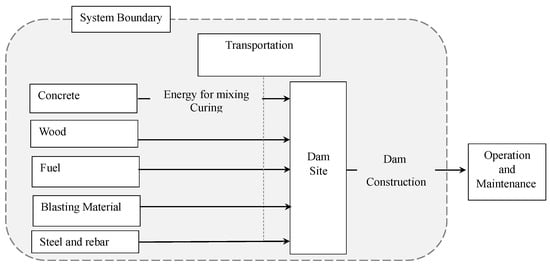
Figure 1.
System boundary for the dam construction stage.
2.3. CFA Method
Carbon footprint analysis (CFA) is a comprehensive assessment that quantifies the total amount of greenhouse gas emissions, measured in carbon dioxide equivalents, associated with a particular activity, product, or process throughout its life cycle [36,37,38,39,40]. It is believed that the exact origin of CFA has emerged from the concept of Ecological Footprint since the 1990s. This analysis aims to provide insights into the environmental impact and sustainability of a given entity by accounting for emissions resulting from resource extraction, manufacturing, transportation, usage, and disposal. By examining the carbon footprint, one can identify key contributors to greenhouse gas emissions and explore opportunities to reduce or offset these impacts [41]. This methodology is crucial in addressing climate change concerns and promoting sustainable practices across various industries, guiding individuals, businesses, and policymakers toward more environmentally responsible choices. In the present work, the outcomes of the LCA conducted using SimaPro are utilized to pinpoint primary emission sources, thereby facilitating an evaluation of the carbon footprint attributed to the dam’s construction [16].
2.4. LCC Method
The concept of life cycle cost (LCC) originated within the US Department of Defense in the 1960s. It presents a comprehensive approach for assessing the total expenses associated with a project or asset across its entire lifespan, employing economic principles [42,43]. The primary objective of LCC is to identify the most economically efficient choices for a material or system and ensure its financial viability over the long term [44]. Recent efforts have focused on adapting LCC methodologies for the construction sector, encompassing investigations that employ LCC to appraise property and construction alternatives and quantify disposal expenditures. In the context of a construction endeavor, LCC considers costs related to design, construction, maintenance, and operation.
3. Model Description
In this study, the Bluestone Dam is selected for LCA. This dam, located on the New River in West Virginia (USA), is a significant structure. Originally constructed in 1930, the dam serves the dual purpose of flood control and hydropower generation [45]. A schematic representation of one of the dam models developed using CADAM [46] is shown in Figure 2.

Figure 2.
A schematic view of the dam modeled using CADAM v1.4.12 software.
A spectral acceleration of 0.36 g corresponds to a return period of 2475 years, where g represents gravitational acceleration. Additionally, the hydrologic analysis suggests that, in the event of an impending dam failure, the reservoir water level could rise to 52 m [47]. In this study, it is assumed that the reservoir is fully filled, with a water depth of 48.15 m, and all analyses are conducted under this condition.
To conduct a comprehensive evaluation encompassing LCA, CFA, and LCC for the dam, it becomes essential to encompass various phases of its existence, ranging from initial construction to eventual demolition and recycling. The creation of an exhaustive life cycle inventory (LCI) database with minimal uncertainties stands as a notable challenge faced by scholars in these domains, acting as a limiting factor in the execution of these assessments.
Table 1 presents the relevant material properties and construction details essential for the dam’s lifecycle, considering 1 m width of the dam [48]. This tabulated information furnishes intricate insights into material weights and on-site and off-site transportation considerations across all phases. Wood is commonly used as a material for constructing temporary formwork and scaffolding during the concrete pouring phase of dam construction. It is important to underscore that, in the phase of demolition and recycling, an assumption has been introduced positing a 20% concrete recycling rate, where a portion of the demolished dam’s concrete finds renewed utility in other construction projects [49].

Table 1.
LCI database for the construction stage.
Table 2 forms the foundational framework for LCC computation, encompassing not only the expenses linked to materials and construction procedures, but also factoring in their consequential impacts, such as the financial implications stemming from environmental emissions.

Table 2.
Price of each operation and construction materials.
4. Results and Discussion
In this part, the outcomes of the LCA, CFA, and LCC investigations are displayed for both phases of the dam’s lifespan: building and eventual decommissioning with recycling. Following this, a comparative examination of the findings from these assessments is carried out for two separate scenarios representing different phases of the dam’s life cycle.
4.1. Construction Stage
4.1.1. Environmental Impacts
Figure 3 demonstrates the carbon footprint distribution across different components and processes involved in the production of concrete. Cement is shown to be the most significant contributor, accounting for nearly 90% of the total emissions, aligning with the typical findings in the literature [16] that highlight cement’s high environmental impact due to energy-intensive production. Aggregates, both fine and coarse, contribute a smaller but notable amount, reflecting the environmental cost of extraction and transportation. Admixture production and transportation have measurable impacts, suggesting that logistics management and minimizing admixture quantities can further reduce emissions. Concrete batching, although a relatively minor component, also adds to the footprint, emphasizing the need for efficient batching processes.
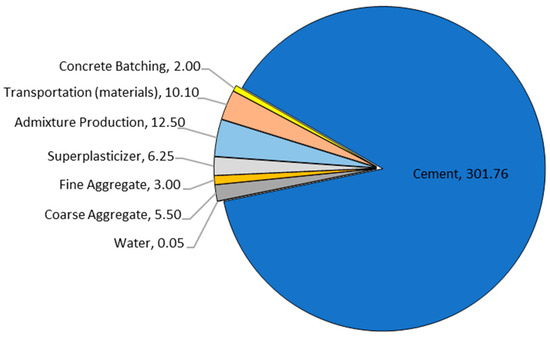
Figure 3.
Carbon footprint distribution across different components and processes involved in the production of concrete (kg CO2 eq).
The analysis’ outcomes, as presented in Table 3, outline the environmental impacts throughout the entire construction phase of 1 m width of the dam. Moreover, Figure 4 presents the distribution of environmental impacts during the construction phase of the dam based on the IMPACT 2002+ method. The bar chart delineates the influence of six components—concrete, transportation, diesel fuel, wood, blasting materials, and steel and rebar—on the overall environmental impacts. The results reveal that the total carbon dioxide equivalent (CO2 eq) emissions amount to approximately 355 ton CO2 eq/m, with the primary contributors being concrete production and fuel usage. Concrete, as one of the most extensively used materials in dam construction, accounts for over 305 ton CO2 eq/m, indicating its substantial role in greenhouse gas emissions. Fuel use, largely associated with transportation and machinery, contributes an additional 33 ton CO2 eq/m. Additionally, aquatic ecotoxicity is primarily driven by the use of blasting materials, which also contribute heavily to terrestrial impacts and land occupation. These findings point to the need for improved practices in material selection and handling to mitigate ecological damage.

Table 3.
The environmental impacts throughout the entire construction of 1 m width of the dam.

Figure 4.
Distribution of environmental impacts during the construction phase of the dam based on the IMPACT 2002+ method.
Energy consumption in the project is another key factor, with over 5,700,000 MJ/m of non-renewable energy being consumed, mostly attributed to fuel use and concrete production. Concrete significantly contributes to carcinogens, non-carcinogens, aquatic eutrophication, global warming, and material extraction. Furthermore, the use of wood is associated with deforestation, leading to reduced clean air production and contributing to environmental degradation, particularly affecting land occupation.
Table 4 outlines the LCA outcomes for dam construction across four specific categories—human health, ecosystem quality, climate change, and resources—utilizing the IMPACT 2002+ methodology. Furthermore, Figure 5 represents the impact of six key components—concrete, transportation, diesel fuel, wood, blasting materials, and steel and rebar—on these aforementioned categories. Concrete production significantly impacts human health, with the total effect estimated at 0.143 disability-adjusted life years (DALY). This impact arises primarily from emissions during cement production, including particulate matter and pollutants such as nitrogen oxides and sulfur dioxide, which contribute to respiratory and cardiovascular issues.

Table 4.
LCA results of construction of 1 m width of the dam using the IMPACT 2002+ method.
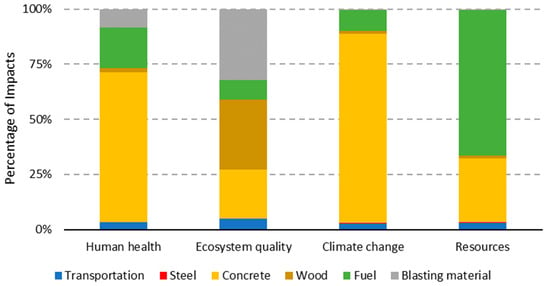
Figure 5.
The distribution of the dam’s components on the environmental impacts.
Additionally, the extraction and processing of raw materials, as well as the energy-intensive nature of concrete manufacturing, release greenhouse gases and airborne toxins that further harm air quality and human health. For concrete batching, the DALY primarily stems from air pollution during cement production, including emissions of particulate matter (PM2.5), nitrogen oxides (NOx), and sulfur dioxide (SO2). Moreover, the results indicate that, in terms of human health (DALY), the most significant contributors are fuel and concrete, together accounting for a large portion of the impact. Fuel contributes the highest, followed closely by concrete, indicating that energy consumption and emissions from these materials and processes are critical factors affecting human health. Other elements like blasting material and transportation also play a role, but are less impactful in comparison.
For ecosystem quality (PDF m2 yr), the most striking result is the overwhelming contribution of blasting materials, which account for the majority of the damage in this category. This suggests that activities related to blasting are highly disruptive to ecosystems, possibly due to habitat destruction. Wood also has a notable impact, likely related to deforestation or land use changes, while other materials like concrete have a much smaller effect on ecosystems. In the climate change (ton CO2 eq) category, concrete is by far the largest contributor, responsible for the vast majority of carbon emissions. This aligns with the energy-intensive nature of concrete production, particularly in cement manufacturing. Fuel also plays a significant role in emissions, reinforcing the need to address fuel usage to mitigate climate change’s impacts. Transportation contributes a smaller but still noteworthy amount of CO2 emissions. Finally, in the resources (MJ primary) category, fuel consumption dominates resource use, indicating a high demand for energy in the processes involved. Concrete follows as the next largest consumer of resources, suggesting that both material production and energy consumption are driving factors in resource depletion.
Figure 6 illustrates the impact of pollution across four categories—resource consumption, ecosystem pollution, climate change, and endangerment to human health—according to the IMPACT 2002+ methodology. The graph provides a comprehensive representation of pollution’s environmental effects by normalizing and weighting the created pollution based on its importance factors, measured in MPt (megapoints). Notably, the graph reveals that pollution generated for climate change and human health holds the top two positions, while pollution related to resources and the ecosystem ranks third and fourth. Concrete consistently emerges as the component with the highest impact in all categories, particularly in climate change, where it scores nearly 0.04 MPt, surpassing the other components such as blasting material.
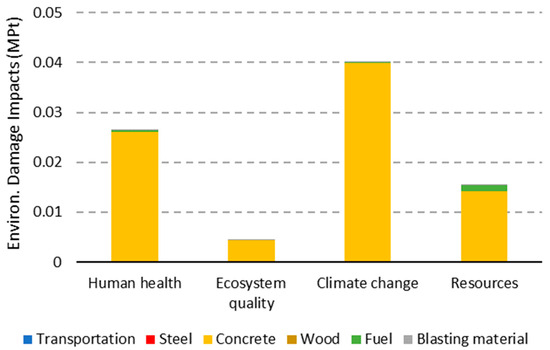
Figure 6.
Total weighted and normalized environmental impacts using IMPACTS 2002+ on the construction of 1 m width of the dam.
4.1.2. LCC Results of the Construction Stage
The results of the LCC analysis reveal that the estimated economic expenses for the dam’s construction phase are anticipated to reach approximately USD 0.195 million. In Figure 7, a graphical depiction illustrates the contributions of different construction materials and operations to these costs. Concrete emerges as the most significant factor, making an impactful contribution of USD 0.0959 million. Excavation follows closely as the second most substantial contributor at USD 0.0384 million, succeeded by oil at USD 0.0270 million.
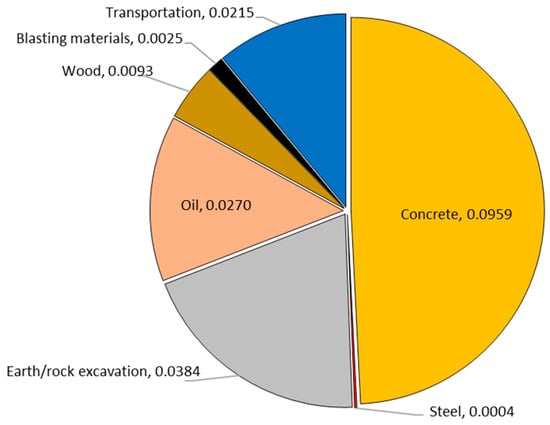
Figure 7.
The results of the LCC analysis for the dam’s construction phase (million USD).
4.2. The Effects of Demolition
By conducting CFA and LCC analyses, the total carbon emission and cost of demolishing the 1 m width of the dam were determined to be 735 ton CO2 eq/m and USD 0.138 million, respectively. Figure 8 illustrates the contributions of the parameters to the CFA and LCC results of dam demolition. The analysis reveals that the most influential parameters affecting carbon emissions during dam demolition are landfill (51%) and blasting material (46%), with transportation accounting for 3%, influenced by landfill location. Similarly, in the LCC results, blasting material is the most significant parameter, contributing to approximately 82% of the total cost.
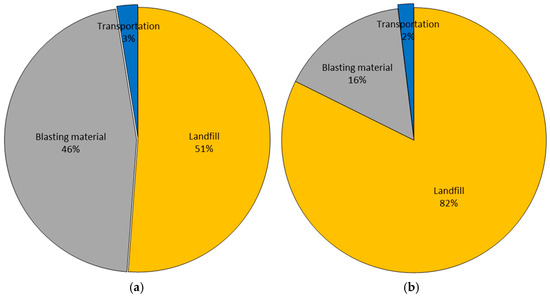
Figure 8.
The contribution of the parameters on the (a) carbon emissions due to the destruction of the dam and (b) the total price of the destruction of the dam.
4.3. The Effects of Recycling
This section assesses the economic and environmental implications linked to the recycling of dam materials. The effects of recycling were considered within the framework of the LCA by specifically examining the environmental impacts associated with the use of recycled materials, such as RCA, in concrete production. This involved quantifying the reduction in energy consumption, emissions, and resource depletion resulting from the substitution of virgin aggregates with recycled materials. Additionally, the end-of-life phase of the recycled materials was analyzed to assess their potential for reuse or recycling, thus contributing to the overall sustainability of the concrete lifecycle.
4.3.1. CFA Results
Figure 9 depicts the carbon footprint generated during the decommissioning of the dam, taking into account the recycling of used concrete and steel. The carbon footprint attributed to the decommissioning process without recycling was calculated using CFA, amounting to approximately 735 ton CO2 eq/m. The results emphasize the significant impact of material recycling on the carbon footprint, showcasing a substantial 95% reduction in greenhouse gas emissions. This underscores the potential of incorporating sustainable waste management practices to alleviate the environmental impacts.

Figure 9.
The effect of recycling steel and concrete on carbon footprint.
4.3.2. LCC Results of Recycling
The findings indicate that the total cost for the demolition of the dam amount to approximately USD 91.6 million. In Figure 10, the impact of recycling on the total cost of dam demolition is illustrated. Notably, the inclusion of recycling concrete and steel results in an increase in the overall cost of dam destruction. For instance, if all the utilized steel and concrete are recycled, the total cost of the dam’s demolition reaches USD 0.142 million. These results emphasize the importance of factoring in both economic and environmental considerations related to waste disposal during the initial design and planning stages of construction projects. This proactive approach is crucial for mitigating adverse impacts and ensuring cost-effectiveness.
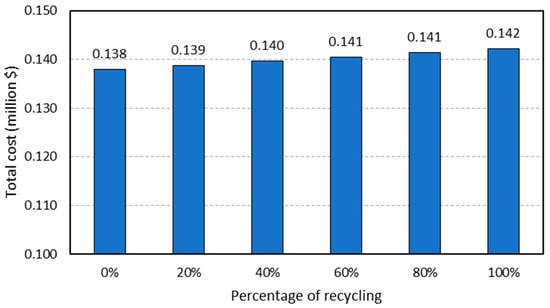
Figure 10.
The effect of recycling steel and concrete on the overall cost of dam destruction.
4.4. The Effects of Compressive Strength of the Concrete
Concrete is a major contributor to the environmental impacts of dam construction, with cement being the most critical factor due to its high carbon footprint. The compressive strength of concrete plays a crucial role in determining the overall sustainability of the structure. Increasing compressive strength can reduce the required volume of concrete in the dam, thereby lowering material consumption. However, this comes at the cost of increased cement content in the mix, which has a significant environmental impact due to its energy-intensive production process.
To explore this trade-off, the effects of different concrete compressive strengths—20 MPa, 30 MPa, 40 MPa, and 50 MPa—are investigated. For each case, the dam is designed to meet the required structural stability while minimizing material use.
By considering the design criteria, the required volume of concrete for a 1 m width of the dam varies with the compressive strength of the concrete. For compressive strengths of 20 MPa, 30 MPa, 40 MPa, and 50 MPa, the corresponding concrete volumes are 994.3 m3, 895.4 m3, 890.5 m3, and 887.2 m3, respectively. Figure 11 presents the carbon footprint associated with the construction of 1 m width of dam using different compressive strengths. The results indicate that although lower compressive strength requires a larger volume of concrete, the total carbon footprint remains lower due to the reduced cement content in the mix. In other words, increasing compressive strength leads to a decrease in concrete volume, but results in a higher carbon footprint, primarily due to the increased cement consumption, which is the dominant contributor to greenhouse gas emissions in concrete production.
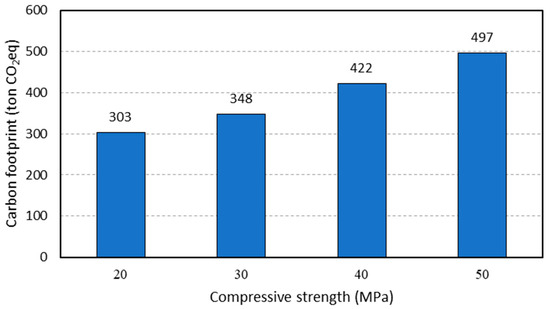
Figure 11.
The effect of increasing the compressive strength of concrete on carbon footprint per 1 m width of the dam.
5. Conclusions
This paper conducts assessments of the LCA, CFA, and LCC for a concrete dam across construction and decommissioning scenarios. While other studies [16,28] have investigated the environmental impacts and costs of dams, this study focuses on the sustainability of dams through material recycling and dam design considerations. It further examines the impact of integrating recycling practices for demolished concrete and steel on the carbon footprint and LCC results by considering different end-of-life scenarios, including material recovery, reuse, and recycling processes. These scenarios assess the environmental benefits of reducing raw material extraction and landfill use, along with the financial implications of recycling logistics and potential savings from reusing materials. In essence, the evaluation of these stages for the dam can be summarized as follows:
- Cement is the largest contributor to the carbon footprint of concrete due to its energy-intensive production. Aggregates and admixtures contribute smaller but meaningful emissions, while transportation and batching also add to the total footprint.
- The findings highlight the significant environmental impact of concrete production and fuel usage, which are the primary contributors to carbon emissions in construction of 1 m width of the dam, with total CO2 eq emissions reaching 355 ton/m. Concrete alone accounts for over 305 ton CO2 eq/m. The project’s non-renewable energy consumption exceeds 5,700,000 MJ/m, largely driven by concrete and fuel.
- Climate change and human health rank as the top environmental concerns, with concrete consistently emerging as the dominant factor in these categories. These findings reinforce the importance of addressing material production and energy consumption to mitigate environmental impacts, particularly in large-scale construction projects such as dam construction.
- The total estimated cost for the dam’s construction phase is approximately USD 0.195 million, with concrete being the most significant contributor, accounting for USD 0.0959 million. Excavation is the second-largest cost at USD 0.0384 million, followed by oil usage at USD 0.0270 million. The overall cost for the decommissioning of the dam is estimated at around USD 0.138 million. Integrating the recycling of concrete and steel leads to an augmentation in the overall cost of dam demolition. To illustrate, if all the employed steel and concrete are recycled, the total cost for the dam’s demolition escalates to USD 0.142 million.
- The carbon footprint resulting from the decommissioning process, excluding recycling, was assessed using CFA and amounted to around 735 ton CO2 eq/m. The outcomes underscore the considerable influence of material recycling on the carbon footprint, demonstrating a notable 95% reduction in greenhouse gas emissions. Recycling concrete as RCA not only reduces waste and conserves natural resources, but also significantly lowers the carbon footprint by decreasing the demand for virgin aggregate extraction. Recycled steel, similarly, can be repurposed in various construction applications, promoting a circular economy approach. These practices contribute to environmental and economic benefits by minimizing landfill usage, reducing greenhouse gas emissions, and aligning with sustainable development goals.
- While lower compressive strength requires more concrete, its total carbon footprint remains lower due to its reduced cement content. Conversely, increasing compressive strength reduces concrete volume, but significantly raises carbon emissions, as cement consumption is the primary contributor to greenhouse gas emissions.
While this study provides valuable insights into the environmental and economic impacts of recycling practices in the context of dam construction and decommissioning, there are some limitations that should be acknowledged. Firstly, the reliance on the assumption of a 20% recycling rate of concrete, based on global averages, may not reflect more optimistic or region-specific recycling practices. Additionally, this study heavily depends on data obtained from previous investigations due to the lack of detailed construction and demolition records for the concrete dam. This reliance on secondary data may introduce uncertainties in the results.
For future research, investigating the operational phases of dams could yield significant insights into their long-term environmental and economic impacts. Specifically, assessing the carbon footprint, life cycle costs, and life cycle impacts associated with dam operations—such as maintenance practices, water management, and emissions from reservoirs—can provide a clearer understanding of how to optimize these phases for sustainability. Additionally, exploring the effects of using RCA and sustainable material innovations in dam construction offers a promising pathway to reduce environmental impacts. RCA’s role in concrete dam design could impact LCC, LCA, and CFA by reducing reliance on virgin materials and mitigating waste. Furthermore, research focused on optimization approaches that minimize environmental impacts—considering factors such as resource consumption, emissions, and ecosystem effects—can lead to the development of more sustainable dam designs.
Author Contributions
Conceptualization, H.M., N.F.C. and P.S.; methodology, H.M., N.F.C. and P.S.; formal analysis, H.M. and N.F.C.; investigation, H.M. and N.F.C.; resources, H.M. and N.F.C.; writing—original draft preparation, H.M. and N.F.C.; writing—review and editing, H.M., M.M., N.S.H. and P.S.; visualization, H.M. and N.F.C.; supervision, H.M. and P.S. All authors have read and agreed to the published version of the manuscript.
Funding
This research received no external funding.
Informed Consent Statement
Not applicable.
Data Availability Statement
The data presented in this study are available on request from the corresponding author. The data are not publicly available due to confidentiality issues.
Conflicts of Interest
The authors declare no conflicts of interest.
Abbreviations
The following abbreviations are used in this manuscript:
| CFA | Carbon footprint analysis |
| GHGs | Greenhouse gases |
| LCA | Life cycle assessment |
| LCC | Life cycle costs |
| LCI | Life cycle inventory |
| RCA | Recycled concrete aggregate |
References
- Mostafaei, H. Modal Identification Techniques for Concrete Dams: A Comprehensive Review and Application. Sci 2024, 6, 40. [Google Scholar] [CrossRef]
- Schmitt, R.J.P.; Rosa, L. Dams for hydropower and irrigation: Trends, challenges, and alternatives. Renew. Sustain. Energy Rev. 2024, 199, 114439. [Google Scholar] [CrossRef]
- Angelakis, A.N.; Baba, A.; Valipour, M.; Dietrich, J.; Fallah-Mehdipour, E.; Krasilnikoff, J.; Bilgic, E.; Passchier, C.; Tzanakakis, V.A.; Kumar, R. Water Dams: From ancient to present times and into the future. Water 2024, 16, 1889. [Google Scholar] [CrossRef]
- Mostafaei, H.; Bahmani, H. Sustainable High-Performance Concrete Using Zeolite Powder: Mechanical and Carbon Footprint Analyses. Buildings 2024, 14, 3660. [Google Scholar] [CrossRef]
- Ali, H.O. Advancing integrated water resources management approaches for the sustainability of small dams in arid and semi-arid regions: A case study of the Um Dafoug dam in South Darfur State, Sudan. Int. J. Water Resour. Environ. Eng. 2025, 17, 1–16. [Google Scholar]
- Bahmani, H.; Mostafaei, H.; Santos, P.; Fallah Chamasemani, N. Enhancing the mechanical properties of Ultra-High-Performance Concrete (UHPC) through silica sand replacement with steel slag. Buildings 2024, 14, 3520. [Google Scholar] [CrossRef]
- Udara Willhelm Abeydeera, L.H.; Wadu Mesthrige, J.; Samarasinghalage, T.I. Global research on carbon emissions: A scientometric review. Sustainability 2019, 11, 3972. [Google Scholar] [CrossRef]
- Schützenhofer, S.; Kovacic, I.; Rechberger, H.; Mack, S. Improvement of environmental sustainability and circular economy through construction waste management for material reuse. Sustainability 2022, 14, 11087. [Google Scholar] [CrossRef]
- Santos, P.; Cervantes, G.C.; Zaragoza-Benzal, A.; Byrne, A.; Karaca, F.; Ferrández, D.; Salles, A.; Bragança, L. Circular Material Usage Strategies and Principles in Buildings: A Review. Buildings 2024, 14, 281. [Google Scholar] [CrossRef]
- Al Omar, S.; Abdelhadi, A. Comparative Life-Cycle Assessment of Steel and GFRP Rebars for Procurement Sustainability in the Construction Industry. Sustainability 2024, 16, 3899. [Google Scholar] [CrossRef]
- Saffari, R.; Habibagahi, G.; Nikooee, E.; Niazi, A. Biological stabilization of a swelling fine-grained soil: The role of microstructural changes in the shear behavior. Iran. J. Sci. Technol. Trans. Civ. Eng. 2017, 41, 405–414. [Google Scholar] [CrossRef]
- Shabani, K.; Bahmani, M.; Fatehi, H.; Chang, I. Improvement of the geotechnical engineering properties of dune sand using a plant-based biopolymer named serish. Geomech. Eng. 2022, 29, 535–548. [Google Scholar]
- Banias, G.F.; Karkanias, C.; Batsioula, M.; Melas, L.D.; Malamakis, A.E.; Geroliolios, D.; Skoutida, S.; Spiliotis, X. Environmental assessment of alternative strategies for the management of construction and demolition waste: A life cycle approach. Sustainability 2022, 14, 9674. [Google Scholar] [CrossRef]
- Zhang, L.W.; Sojobi, A.O.; Kodur, V.K.R.; Liew, K.M. Effective utilization and recycling of mixed recycled aggregates for a greener environment. J. Clean. Prod. 2019, 236, 117600. [Google Scholar] [CrossRef]
- Yu, Y.; Pacheco-Torgal, F.; Zhao, X.-Y.; Wang, X.-L. Cleaner production of the precast concrete industry: Comparative life cycle analysis of concrete using recycled aggregates from crushed precast rejects. Eur. J. Environ. Civ. Eng. 2024, 28, 1014–1038. [Google Scholar] [CrossRef]
- Mostafaei, H.; Rostampour, M.A.; Chamasemani, N.F.; Wu, C. An In-Depth Exploration of Carbon Footprint Analysis in the Construction Sector with Emphasis on the Dam Industry. In Carbon Footprint Assessments: Case Studies & Best Practices; Springer: Berlin/Heidelberg, Germany, 2024; pp. 45–80. [Google Scholar]
- Song, C.; Gardner, K.H.; Klein, S.J.W.; Souza, S.P.; Mo, W. Cradle-to-grave greenhouse gas emissions from dams in the United States of America. Renew. Sustain. Energy Rev. 2018, 90, 945–956. [Google Scholar] [CrossRef]
- Zhang, C.; Hu, M.; van der Meide, M.; Di Maio, F.; Yang, X.; Gao, X.; Li, K.; Zhao, H.; Li, C. Life cycle assessment of material footprint in recycling: A case of concrete recycling. Waste Manag. 2023, 155, 311–319. [Google Scholar] [CrossRef] [PubMed]
- Suwanit, W.; Gheewala, S.H. Life cycle assessment of mini-hydropower plants in Thailand. Int. J. Life Cycle Assess. 2011, 16, 849–858. [Google Scholar] [CrossRef]
- Chhun, B.; Bonnet, S.; Gheewala, S.H. Life cycle assessment of the Kamchay hydropower plant in Cambodia. J. Sustain. Energy Environ. 2021, 12, 23–33. [Google Scholar]
- Pang, M.; Zhang, L.; Wang, C.; Liu, G. Environmental life cycle assessment of a small hydropower plant in China. Int. J. Life Cycle Assess. 2015, 20, 796–806. [Google Scholar] [CrossRef]
- Sadok, R.H.; Belaribi, N.B.; Mazouzi, R.; Sadok, F.H. Life cycle assessment of cementitious materials based on calcined sediments from Chorfa II dam for low carbon binders as sustainable building materials. Sci. Total Environ. 2022, 826, 154077. [Google Scholar] [CrossRef] [PubMed]
- Pacca, S. Impacts from decommissioning of hydroelectric dams: A life cycle perspective. Clim. Change 2007, 84, 281–294. [Google Scholar] [CrossRef]
- Rosa, L.P.; Dos Santos, M.A.; Matvienko, B.; Dos Santos, E.O.; Sikar, E. Greenhouse gas emissions from hydroelectric reservoirs in tropical regions. Clim. Change 2004, 66, 9–21. [Google Scholar] [CrossRef]
- Fearnside, P.M. Greenhouse gas emissions from hydroelectric dams in tropical forests. In Alternative Energy and Shale Gas Encyclopedia; John Wiley & Sons, Inc.: Hoboken, NJ, USA, 2016; pp. 426–436. [Google Scholar]
- Zhang, S.; Zhang, S.; Wu, Z.; Wang, X.; Jiang, Z.; Wang, C.; Zhao, G. IFC-enabled LCA for carbon assessment in pumped storage hydropower (PSH) with concrete face rockfill dams. Autom. Constr. 2023, 156, 105121. [Google Scholar] [CrossRef]
- Liu, C.; Ahn, C.R.; An, X.; Lee, S. Life-cycle assessment of concrete dam construction: Comparison of environmental impact of rock-filled and conventional concrete. J. Constr. Eng. Manag. 2013, 139, A4013009. [Google Scholar] [CrossRef]
- Zhang, S.; Pang, B.; Zhang, Z. Carbon footprint analysis of two different types of hydropower schemes: Comparing earth-rockfill dams and concrete gravity dams using hybrid life cycle assessment. J. Clean. Prod. 2015, 103, 854–862. [Google Scholar] [CrossRef]
- IS 6512; Criteria for Design of Solid Gravity Dams (Second Revision). Bureau of Indian Standards (BIS): New Delhi, India, 2019.
- Sharma, S. Fostering Green Product Design and Innovation for a Sustainable Future. In Waste Management and Life Cycle Assessment for Sustainable Business Practice; IGI Global: Hershey, PA, USA, 2024; pp. 86–110. [Google Scholar]
- Sakib, M.N.; Kabir, G.; Ali, S.M. A life cycle analysis approach to evaluate sustainable strategies in the furniture manufacturing industry. Sci. Total Environ. 2024, 907, 167611. [Google Scholar] [CrossRef]
- Akintayo, B.D.; Babatunde, O.M.; Olanrewaju, O.A. Comparative Analysis of Cement Production Methods Using a Life Cycle Assessment and a Multicriteria Decision-Making Approach. Sustainability 2024, 16, 484. [Google Scholar] [CrossRef]
- Yuguda, T.K.; Li, Y.; Xiong, W.; Zhang, W. Life cycle assessment of options for retrofitting an existing dam to generate hydro-electricity. Int. J. Life Cycle Assess. 2020, 25, 57–72. [Google Scholar] [CrossRef]
- Curran, M.A. Life-Cycle Assessment: Principles and Practice; National Risk Management Research Laboratory, Office of Research and Development, U.S. Environmental Protection Agency: Cincinnati, OH, USA, 2006. [Google Scholar]
- Barbhuiya, S.; Das, B.B. Life Cycle Assessment of construction materials: Methodologies, applications and future directions for sustainable decision-making. Case Stud. Constr. Mater. 2023, 19, e02326. [Google Scholar] [CrossRef]
- Momotaz, H.; Rahman, M.M.; Karim, M.R.; Zhuge, Y.; Ma, X.; Levett, P. Comparative study on properties of kerb concrete made from recycled materials and related carbon footprint. J. Build. Eng. 2023, 72, 106484. [Google Scholar] [CrossRef]
- Wang, C.; Chen, B.; Vo, T.L.; Rezania, M. Mechanical anisotropy, rheology and carbon footprint of 3D printable concrete: A review. J. Build. Eng. 2023, 76, 107309. [Google Scholar] [CrossRef]
- Mostafaei, H.; Kelishadi, M.; Bahmani, H.; Wu, C.; Ghiassi, B. Development of sustainable HPC using rubber powder and waste wire: Carbon footprint analysis, mechanical and microstructural properties. Eur. J. Environ. Civ. Eng. 2025, 29, 399–420. [Google Scholar] [CrossRef]
- Bahmani, H.; Mostofinejad, D. Sustainable high-performance concrete with sugar factory lime waste-activated slag and fiber reinforcement: Mechanical properties and environmental impact. Constr. Build. Mater. 2025, 464, 140202. [Google Scholar] [CrossRef]
- Bahmani, H.; Mostofinejad, D. A novel development of ultra-high-performance concrete with calcium oxide-activated materials and fibers: Engineering properties and sustainability evaluation. Mag. Concr. Res. 2024, 76, 882–902. [Google Scholar] [CrossRef]
- Cordoba, G.; Irassar, E.F. Carbon footprint of reinforced concrete columns with and without supplementary cementitious materials. Int. J. Life Cycle Assess. 2023, 28, 800–812. [Google Scholar] [CrossRef]
- Hassan, H.F.; Al-Shamsi, K.; Al-Jabri, K. Effect of Steel Slag on the Permanent Deformation and Life Cycle Cost of Asphalt Concrete Pavements. Int. J. Pavement Res. Technol. 2023, 17, 1513–1530. [Google Scholar] [CrossRef]
- Njotea, B.A.; Okonkwo, V.O.; Mezie, E.O.; Nwankwoeke, C.H. Investigation of the Economic and Life Cycle Cost Benefits of Concrete Pavement over Asphalt Pavement: Case Study of Isieke Road, Ebonyi State. Saudi J. Civ. Eng. 2023, 7, 29–39. [Google Scholar]
- Kromoser, B.; Butler, M.; Hunger, M.; Kimm, M.; Kopf, F.; Mechtcherine, V.; Pressmair, N.; Traverso, M. Article of RILEM TC 292-MCC: Life cycle assessment (LCA) of non-metallic reinforcement for reinforcing concrete: Manufacturing, durability, dismantling, recycling and reuse: A review. Mater. Struct. 2023, 56, 126. [Google Scholar] [CrossRef]
- Ellingwood, B.; Tekie, P.B. Fragility analysis of concrete gravity dams. J. Infrastruct. Syst. 2001, 7, 41–48. [Google Scholar] [CrossRef]
- Leclerc, M.; Léger, P.; Tinawi, R. Computer aided stability analysis of gravity dams—CADAM. Adv. Eng. Softw. 2003, 34, 403–420. [Google Scholar] [CrossRef]
- Tekie, P.B.; Ellingwood, B.R. Seismic fragility assessment of concrete gravity dams. Earthq. Eng. Struct. Dyn. 2003, 32, 2221–2240. [Google Scholar] [CrossRef]
- Baghlani, A.; Sattari, M.; Makiabadi, M.H. Application of genetic programming in shape optimization of concrete gravity dams by metaheuristics. Cogent Eng. 2014, 1, 982348. [Google Scholar] [CrossRef]
- Gauthier, D. European Cement Research Academy Technical Report; Report, no. 1001-0742; European Cement Research Academy: Duesseldorf, Germany, 2015. [Google Scholar]
Disclaimer/Publisher’s Note: The statements, opinions and data contained in all publications are solely those of the individual author(s) and contributor(s) and not of MDPI and/or the editor(s). MDPI and/or the editor(s) disclaim responsibility for any injury to people or property resulting from any ideas, methods, instructions or products referred to in the content. |
© 2025 by the authors. Licensee MDPI, Basel, Switzerland. This article is an open access article distributed under the terms and conditions of the Creative Commons Attribution (CC BY) license (https://creativecommons.org/licenses/by/4.0/).